Herbaceous plant known to have medicinal properties, is used by indigenous people in India
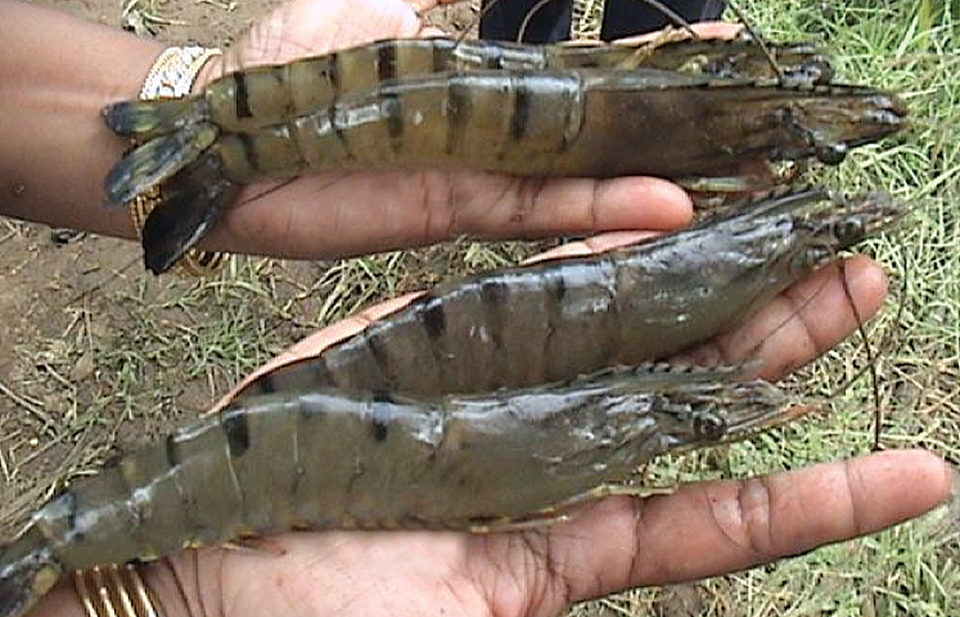
Medicinal herbs have been tested and used with good results in the control of viral and bacterial diseases in shrimp. Boerhaavia diffusa, commonly known as red hogweed and punarnava in Sanskrit, is a herbaceous plant of the family Nyctaginaceae. Known to have medicinal properties, the plant and its specific parts have a long history of use by indigenous and tribal people in India. The root juice is used to cure asthma, urinary disorders, leukorrhea, rheumatism and encephalitis. It is also commonly used as an immunostimulant in the traditional ayurvedic system.
Plant antiviral properties
The roots of punarnava are a rich source of a basic protein used for inducing systemic resistance in many susceptible crops against commonly occurring viruses. Studies have shown that the purified glycoprotein from punarnava exhibits strong antimicrobial activity against RNA bacteriophages. This protein or antiviral agent is active against tobacco mosaic virus, sunn hemp rosette virus and gomphrena mosaic virus when applied two to 24 hours before inoculation by the respective inoculum of viruses.
The root glycoprotein functions as a signal molecule and is of great interest because it has a role in stimulating the defense systems of plants against viruses. Owing to the high antiviral efficacy of punarnava, it was tested under field conditions as well as against a few viral diseases of economically important crops. The purified glycoprotein from punarnava reduced infection and multiplication of tomato yellow leaf curl virus, papaya ring spot virus and cucumber green mottle mosaic virus.
Resistance to WSSV
In research by the authors, comparisons of various dosages of punarnava revealed that it has strong antiviral properties against white spot syndrome virus (WSSV) in shrimp. Animals fed higher dosages of punarnava extract survived until the experiment was terminated 14 days after WSSV infection.
A possible mechanism for the antiviral activity may be the reaction between the bioactive compound in the extract and the envelope proteins of the virus, which prevents the entry of the virus into the host. The bioactive compound may prevent the multiplication of the virus in the host cell.
Another suggestion is that the bioactive compound in punarnava might act as an immunostimulant like prophenoloxidase, superoxide anion or nitric oxide of shrimp to enhance innate immunity against WSSV. The antioxidant property of the active compound protects the cells from the free radicals raised as a result of WSSV infection.
Growth-promoting potential
Results from a pond trial clearly revealed the growth-promoting potential of an alcohol extract of punarnava in tiger prawns (Fig. 1). Higher growth was observed in punarnava-fed shrimp when compared to a control. Maximum growth reached 10 ml/kg fed shrimp (Table 1). During sampling, the shrimp under treatment were healthy, active and brighter in color than the control animals.
Chithambaran, Growth of P. monodon, Table 1
| Parameter | Control | 8 ml/kg | 10 ml/kg |
|---|---|---|---|
| Initial length (mm) | 18.0 ± 0.2 | 18.0 ± 0.2 | 18.0 ± 0.2 |
| Final length (cm) | 15.2 ± 0.3a | 17.0 ± 0.3b | 19.0 ± 0.3c |
| Initial weight (mg) | 45.0 ± 0.1 | 45.0 ± 0.1 | 45.0 ± 0.1 |
| Final weight (g) | 20.1 ± 2.1a | 23.8 ± 2.3b | 25.4 ± 2.9c |
| Total biomass (kg) | 1,467 | 1,690 | 1,778 |
| Survival (%) | 73 | 71 | 70 |
| Weight increase (%) | 0 | 15 | 22 |
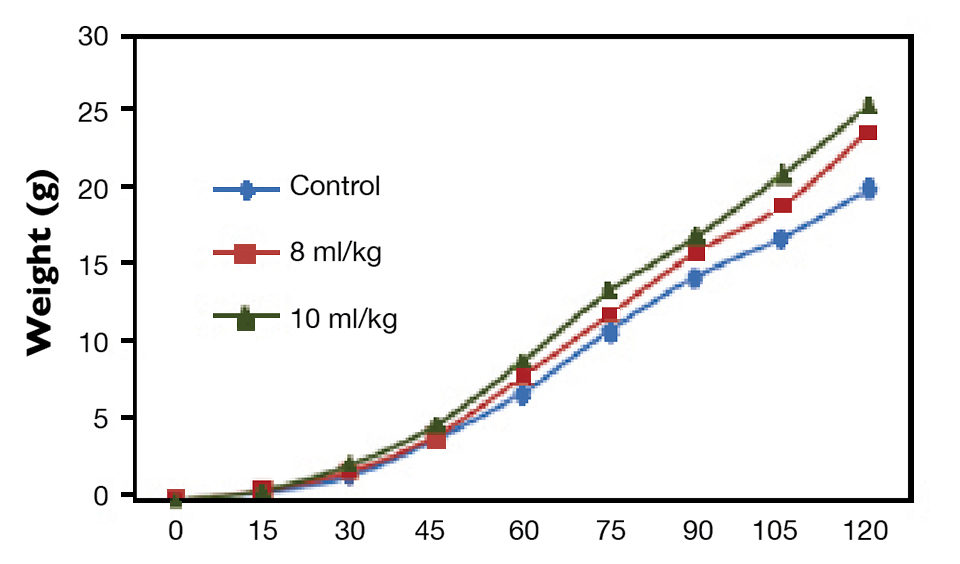
The higher growth observed in the treatment group may have been due to the immunomodulatory effect of the bioactive compound in the herbal extract, which might have induced voluntary feed intake.
Exogenous punarnava was found to increase digestive enzyme activity in the alimentary canals of goats by stimulating the acinar cells in their gastrointestinal tracts. The increase in feed-conversion efficiency of the shrimp that received the extract could be due to the increased digestive enzyme activity in the alimentary canal or the increased rate of assimilation (Table 2).
Chithambaran, Feed utilization of P. monodon, Table 2
| Parameter | Control | 8 ml/kg | 10 ml/kg |
|---|---|---|---|
| Feed consumption (g) | 21.11a ± 1.03 | 22.21ab ± 2.88 | 24.01c ± 1.89 |
| Assimilation (g) | 16.89 ± 1.12 | 18.80 ± 1.12 | 19.80 ± 1.12 |
| Feed-conversion efficiency | 18.19a ± 2.73 | 21.00b ± 2.01 | 24.79c ± 2.08 |
| Feed assimilation efficiency (%) | 70.11 ± 0.71 | 73.11 ± 0.01 | 78.11 ± 0.72 |
| Apparent protein digestibility (%) | 64.32 ± 0.01 | 65.30 ± 2.40 | 70.12 ± 0.88 |
| Apparent lipid digestibility (%) | 76.12 ± 0.99 | 80.12 ± 3.60 | 78.11 ± 0.23 |
Table 2. Feed utilization of P. monodon fed diets with punarnava.
Immunomodulatory properties
A low-circulating hemocyte count is strongly correlated with greater sensitivity to pathogens, and higher total hemocyte counts in hemolymph is correlated with the health of shrimp. Quantitative assessment of hemocyte populations has been proposed as a means to measure cellular immunological response in crustaceans.
Three morphologically distinct types of hemocyte – hyaline, granular and semi-granular – have been identified in shrimp. These cell types demonstrate a variety of activities, including phagocytosis, encapsulation and nodular aggregation. THC was reported to decrease significantly in L. vannamei infected with Taura syndrome virus.
In the present study, total hemocyte counts showed a notable increase in extract-fed shrimp compared to the control. This may have resulted from the stimulatory effect of compounds present in punarnava for the synthesis of hemocytes in the body.
The RNA:DNA ratio indicates the activity of protein synthesis and could be a sensitive tool for investigating the effectiveness of different diets in promoting growth. In the present experiment, RNA:DNA ratios were higher in the treated shrimp than in the control animals (Table 3). A higher RNA:DNA ratio indicates high protein synthesis, which is also an index of growth per cell.
Chithambaran, RNA:DNA ratio in the muscle, Table 3
| Parameter | Control | 8 ml/kg | 10 ml/kg |
|---|---|---|---|
| Muscle | |||
| RNA (µ/g) | 98.34 ± 2.86a | 103.33 ± 1.32b | 148.24 ± 2.07c |
| DNA (µ/g) | 10.03 ± 0.52 | 11.12 ± 0.27 | 11.62 ± 0.44 |
| RNA:DNA | 9.80 ± 0.81a | 9.36 ± 0.33a | 13.48 ± 0.73b |
| Hepatopancreas | |||
| RNA (µ/g) | 119.33 ± 1.02a | 120.10 ± 1.02a | 136.73 ± 1.07b |
| DNA (µ/g) | 9.73 ± 0.13 | 9.50 ± 0.09 | 9.30 ± 0.09 |
| RNA:DNA | 13.20 ± 0.63ab | 12.61 ± 0.36a | 15.27 ± 0.72c |
Table 3. RNA:DNA ratio in the muscle and hepatopancreas of shrimp.
DNA concentrations in cell nuclei are considered an index of cell numbers that contribute to the unit weight of tissue, while RNA concentrations relate to the metabolic functions of tissue. It can be inferred that the high growth rate observed in punarnava-fed shrimp may be due to the enhanced protein synthesis.
Perspectives
The aqueous crude extract from the dried roots of punarnava was found significantly active against viruses that affect mung beans, watermelons, musk melons and gourds. In treated plants, the antiviral agent from punarnava not only decreased disease symptom severity but also protected the plants against infection.
Although numerous studies prove the antiviral property of punarnava against plant viruses, the authors’ research examined the impacts of punarnava in resisting WSSV in penaeid shrimp. The antiviral agent isolated from this plant was found to be a glycoprotein with a molecular weight of 16 to 20 kDa. Since it has strong activity against WSSV, further work on the isolation and characterization of the active compound of the herb needs to be carried out to apply it further in shrimp culture.
(Editor’s Note: This article was originally published in the May/June 2011 print edition of the Global Aquaculture Advocate.)
Authors
-
Dr. Sambhu Chithambaran
Faculty of Marine Sciences
King Abdulaziz University
Saudi Arabia[109,111,99,46,111,111,104,97,121,64,117,104,98,109,97,115,99]
-
Dr. Sherly David
Department of Zoology
All Saint’s College
Thiruvananthapuram, Kerala, India
Related Posts

Responsibility
A look at various intensive shrimp farming systems in Asia
The impact of diseases led some Asian shrimp farming countries to develop biofloc and recirculation aquaculture system (RAS) production technologies. Treating incoming water for culture operations and wastewater treatment are biosecurity measures for disease prevention and control.
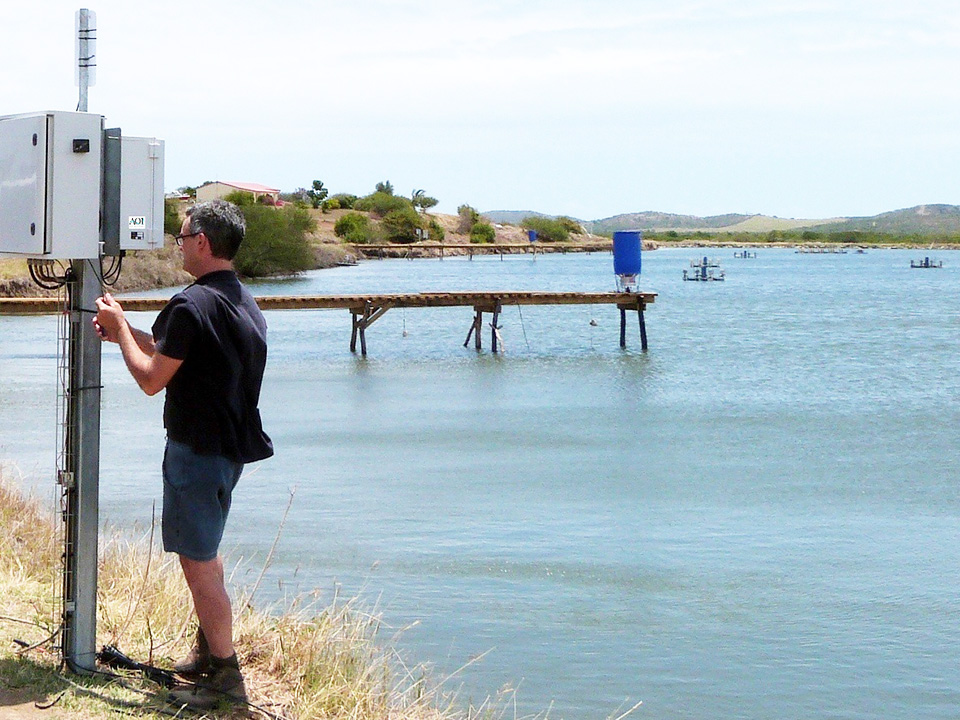
Innovation & Investment
Acoustic control improves feeding productivity at shrimp farms
In systems recently developed for shrimp farms, passive acoustic-based technology enables sensor-based control of multiple automatic feeders. Improved growth and feed conversion have been recorded at commercial farms using the technology.
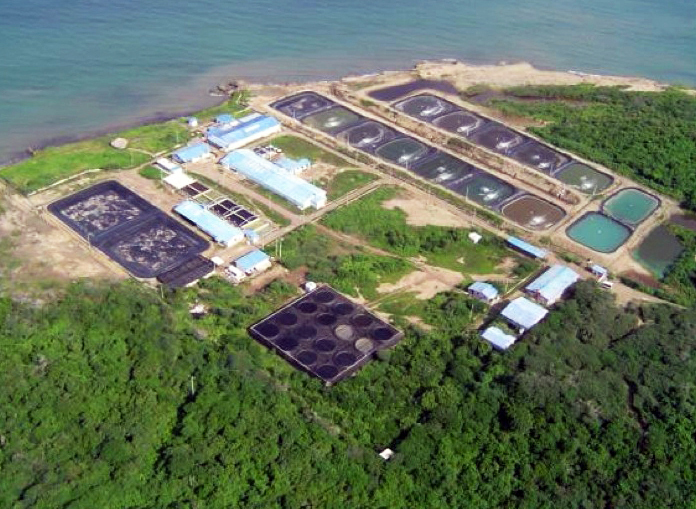
Health & Welfare
CENIACUA develops WSSV-resistant shrimp in Colombia
To combat white spot syndrome virus (WSSV) in white shrimp, Corporación Centro de Investigación de la Acuacultura de Colombia (CENIACUA) initiated a selective-breeding program to develop resistance in shrimp.
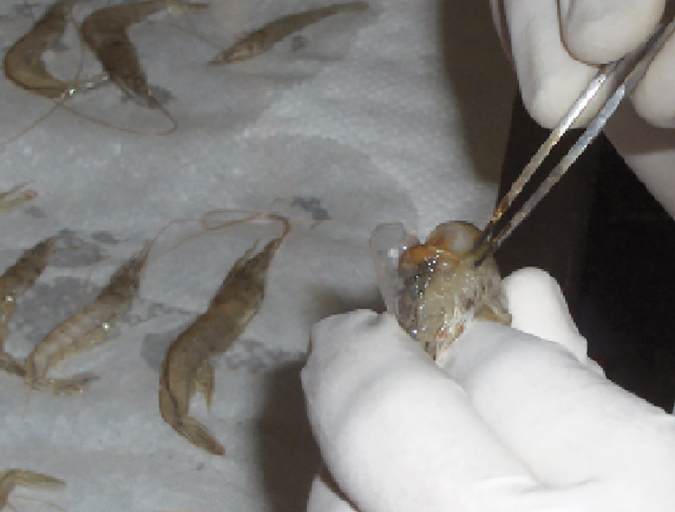
Health & Welfare
Double-stranded RNA against WSSV genes provides antiviral protection in shrimp
Silencing genes in white spot syndrome virus (WSSV) with critical roles in replication could provide a strong antiviral effect and thus reduce shrimp mortality. The authors therefore established a study to evaluate the antiviral efficacy of double-stranded (ds)RNA against non-structural WSSV genes.


